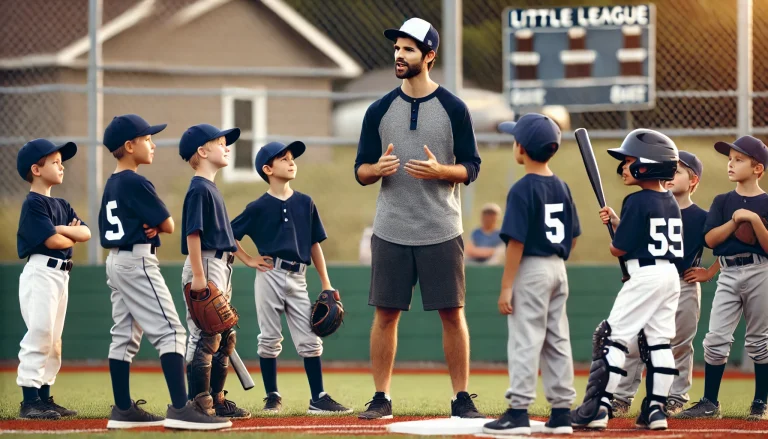Introduction
One of the most essential roles of a Little League coach each season is bringing young players together and molding them into a true team. It’s easier said than done, but it turns game days into unforgettable experiences when it works.
Team-building in Little League is more than just fun and games (though that’s a big part!). It’s about creating a “baseball family” where every player matters—from the ace pitcher to the last kid on the bench.
Team-Building Activities
Why Team Unity Matters
On a Little League team, you’ll often find:
- Players from different schools and backgrounds
- A range of skill levels and experience
- Ages spanning 2–3 years
- Varying levels of baseball knowledge
- Different levels of confidence
Your job? Turn that diverse group into a supportive, cohesive unit that:
- Lifts each other up through wins and losses
- Celebrates everyone’s contributions
- Works together on and off the field
- Builds lasting friendships
- Creates memorable baseball experiences
A team that plays together stays together—and, more importantly, they play better baseball too. Ready to build that championship chemistry without breaking team rules or your coaching sanity?

Dugout Unity: Creating a Team Vibe
The best Little League teams have dugouts that sound more like pep rallies. That’s no accident—the dugout is your team’s home base for building unity, where every player has a role, whether in the lineup or not.
Team-Building Activities
Creating Dugout Energy
Make your dugout the heart of the team:
- Team Cheerleaders: Rotate players as designated cheerleaders between innings.
- Chants and Cheers: Create simple, positive chants that everyone can join in on.
- Steady Encouragement: Keep a drumbeat of support for all players.
- Small Wins Matter: Celebrate small victories, not just big plays.
Keeping Bench Players Engaged
Sitting out doesn’t mean sitting still:
- “Baseball IQ” Spotters: Assign players to track opponents’ tendencies.
- Pitch Trackers for Beginners: Encourage younger players to practice focus by tracking pitches.
- Lineup Announcers: Assign a player to announce the batting order.
- On-Deck Buddies: Pair up bench players with those on deck for encouragement.

Game Day Traditions for Team Spirit
Every great team has its own game day traditions:
- Pre-Inning Huddles: Huddle for quick team boosts before innings.
- Quick Handshakes: Create fun, short handshakes before each inning.
- Rally Caps: Bring out the rally caps when it’s crunch time (yes, they still work!).
Team-Building Activities
Dugout Don’ts: Keep It Positive and Proper
- No negative talk about teammates
- No mocking opponents
- No complaints about playing time
- No isolating players or forming cliques
Your dugout should be more than just a place to sit during the game—it’s the heart of your team’s spirit. Make it a place every player wants to be, even when not on the field.
Baseball-Focused Activities: Building Skills and Team Spirit
Think baseball drills can’t build team spirit? Think again! Here’s how to turn everyday practice into team-building gold while strengthening skills.
Practice with Purpose
Combine competition and teamwork:
- Around-the-Horn Relay Challenge: Teams compete for the cleanest throws. The winning team gets to choose the dugout DJ!
- Infield/Outfield Communication Drills: Award points for proper communication—teamwork wins over individual show-offs.
- Base Running Relay Races: Teams should consist of players with different speed levels so that everyone participates and supports one another.
Mini-Tournaments for Team Spirit
Small competitions keep practice fresh:
- Three-Team Rotating Scrimmage: Play quick innings with players rotating positions and teams, letting them coach each other.
- Skills Challenge Stations: Set up skill stations where players of all levels teach and learn from one another, celebrating improvements.
Team Practice Challenges
Set team goals that require everyone’s effort:
- Perfect Inning Challenge: Work on defensive plays until each position is covered excellently.
- Total Team Batting Practice: Track consecutive solid contacts—everyone’s at-bats contribute to the team’s record.
Tracking Team Success
Celebrate team progress:
- Set weekly improvement goals.
- Track team achievements on a board to reinforce collective wins
- Use an effort points system to reward dedication.
Remember: Baseball is a team sport played by individuals. Your job is to make each of them want to play as a team.
Creating Team Traditions: Building Identity and Belonging
Great teams aren’t just about talent—they’re about traditions that make them unique and give players something bigger to belong to. As a coach, you play a crucial role in creating and maintaining these traditions.
Pre-Game Rituals that Build Identity
Keep it simple and personal:
- Team Entrance Songs: Let players choose an entrance song to play as they walk onto the field.
- Pre-Game Huddles: Use huddle words that the team can rally around.
- Warm-Up Routines: Develop a unique warm-up routine that’s “yours.”
- Special Game Gear: Consider fun additions, like game-day wristbands.
Post-Game Connections
Win or lose, end on a high note:
- Team Handshakes: Make post-game handshakes meaningful with a unique move.
- Game Ball Ceremonies: Present the game ball to a player who exemplified effort.
- Reflection Circles: Take a moment after games for quick, positive reflections.
Season-Long Traditions
Build traditions that bring the team closer over the season:
- Helmet decorations for home runs
- First Hit Baseball Saves: Let players keep their first hit baseball.
- Progress Photos: Create a progress wall to capture the season’s journey.
Little League Coaching 101: Team-Building Activities
Off-Field Connections: Strengthening Bonds Beyond the Diamond
Team chemistry isn’t built only on the field. Coaches have a responsibility to turn off-field time into team-building opportunities.
Baseball Watch Parties
Turn MLB viewing into team bonding:
- Host team watch parties
- Attend local games together
- Track favorite MLB teams and players
- Study pro techniques and discuss them as a group
Team Gatherings That Work
Keep gatherings low-key and fun:
- Celebrate with pizza parties after big games
- Organize team BBQs with parents vs. players’ games
- Plan outings to the local batting cage
- Host bowling nights or ice cream get-togethers
Team-Building Activities
Community Connection
Build pride through service:
- Field clean-up days
- Help with youth clinics
- Volunteer at local tournaments
- Organize equipment drives for new players
Team-Building Activities
Conclusion: Building a Real Team
You can have nine all-stars on the field and still lose to a team that plays like family. Little League magic isn’t just about talent—it’s about turning a group of kids in matching jerseys into a true team.
What Really Matters
The scoreboard might forget these moments, but your players won’t:
- The dugout rally cap dance
- That first pizza party where the shyest player became the loudest
- The practice when everyone cheered for a player’s first hit
- The chants that made parents scratch their heads
- The end-of-season celebration where no one wanted to leave
The Long Game
Strong team-building creates:
- Players who love coming to practice
- Kids who make friends beyond school circles
- Memories that outlast any trophy
- Players who grow up understanding teamwork
- Parents who thank you years later

Keep This in Mind
Your success as a coach isn’t just about:
- Win-loss records
- Perfect practices
- Individual stats
- Tournament trophies
It’s about creating an environment where:
- Every player matters
- Everyone belongs
- Baseball is fun
- Teammates become friends
- Memories are made
Years from now, your players might forget their batting averages, but they’ll never forget how it felt to be part of a real team.
Share Your Favorite Team-Building Moment!
What’s the most memorable team-building activity you’ve done? Comment below and share your coaching stories with others!
Little League Coaching 101: Team-Building Activities
FAQs:
What age group is best suited for these team-building activities?
These activities are designed for Little League players ages 8 to 12. However, most can be easily adapted for older or younger teams.
How much time should I dedicate to team-building activities during practice?
Try setting aside 10-15 minutes each practice for team-building. It’s enough time to build camaraderie without taking away from skills development.
What if my team needs to respond better to some of the activities?
Each team is unique, so it’s normal if some activities work better than others. Feel free to adjust, switch things up, and find what best suits your players’ personalities.
Do team-building activities work even for very young or inexperienced teams?
Absolutely! In fact, team-building can be especially valuable for younger or less experienced players as it helps them feel comfortable, confident, and connected with their teammates.
What’s a quick team-building activity I can use on game day?
Simple activities like pre-game huddles, cheers, or assigning a player to announce the lineup can quickly boost team spirit without disrupting your game-day focus.
How can I involve parents in team-building without overwhelming them?
Parents can be a great asset! Invite them to help with game day traditions, host off-field gatherings, or organize community service activities with the team. Just keep it optional and fun!
Can these activities help improve players’ performance?
Yes! Team-building activities foster a supportive atmosphere, which can boost players’ confidence and motivation and ultimately contribute to better performance on the field.






